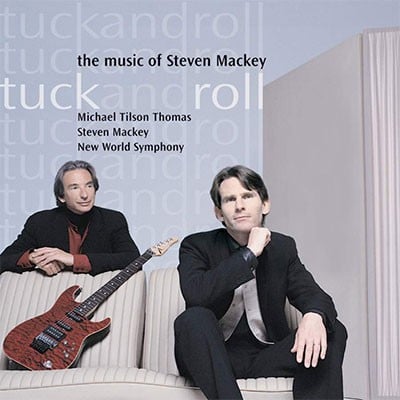3.3.3.tsax.3-4.3.3.1-timp.perc(4)-gtr-harp-kbd synth-strings
This work requires additional technological components and/or amplification.
Abbreviations (PDF)
Boosey & Hawkes (Hendon Music)
There is a musicians’ joke that goes, ‘How do you get an electric guitar player to shut up?’ Answer: ‘Put music in front of him.’ Generally speaking, guitarists don’t read music in the same sense that, say, cellists do. Cellists are trained to read music the way an actor reads a play, even at sight endowing it with character, history, and many levels of psychology; they interpret. Guitarists read music like drivers in a foreign city reading road-signs; they decode. After all, the guitar evolved from an aural and improvised tradition. With that in mind, I left the guitar part open for improvisation in my first electric guitar concerto, Deal, written for jazz great Bill Frisell.
When Michael Tilson Thomas and the New World Symphony asked me to compose a piece in which I would be the guitar soloist, I was excited about the possibility of composing a piece for which I was the best qualified soloist. It’s not that I’m a blazing, state-of-the-art virtuoso, I’m not (although I was hot when I was 18). But, over the past decade I’ve developed an approach to the guitar that draws on my checkered past as a rock guitar player, my training in classical guitar and lute, and my experience performing my own, fully-notated works for the electric guitar in ‘legit’ chamber music contexts (including three pieces for electric guitar and string quartet).
Where Deal is driven by the culture gap between the improvising guitarist and the interpreting orchestral musicians, Tuck and Roll explores various ways of playing together: unison playing, call and response, and intricate interplay between the guitar and sub-groups of the orchestra. While I might assert that the culture/training gap between me and the orchestra is small, there is no denying that the electric guitar brings a distinct new sound and attitude to the orchestral palette. This fact is a primary source of inspiration for the character, lines, and textures of Tuck and Roll.
Tuck and Roll is in four movements. In broad terms, the first and last are exuberant and celebratory; the inner movements are moody. Since the music is restless, somewhat of a road trip, really, I offer a brief description of the lay of the land to help the listener track the journey.
The first movement works with two main ideas. The first is an anthem/fanfare melody which is always accompanied by a complex, almost chaotic-sounding rhythm in the percussion. This takes about a minute-and-a-half to achieve its full flavor, after which the guitar makes a solo entry using the bumpy percussion rhythm. After a brief return to the anthem the guitar has another solo statement, this time a down-and-dirty riff, Eric Clapton meets Leoš Janácek. The rest of the movement develops that idea extensively.
Dark Caprice has a more mercurial continuity and a more quirky topography. After a brief introduction, there is a sequence of short sections with descriptive performance indications: ‘a plodding, nasty, mutant groove,’ ‘psychedelic carousel,’ ‘akimbo,’ ‘bright and jubilant.’ In wander versions of the anthem and the down-and-dirty riff from the first movement. It begins ‘breezy’ and culminates in a wacky passage for bottleneck slide guitar (a technique from old time Mississippi delta blues). When the din subsides, the music begins to pull itself out of this disoriented funk and eventually succeeds with an athletic guitar solo accompanied by brass and bells. The movement ends with a coda: a fuzzy, nostalgic recollection of the anthem.
Intrigue is less willful and capricious and more lyrical and sensuous than the second movement. I think of it in two halves. The first is a slowly evolving kaleidoscopic image, kind of spacey and eerie. The second half is more clearly melodic with a stylized film noir passion.
Puffe refers to a 16th-century instrumental dance that is related, I believe, to the Allemande. As a lutenist, my showstopper was My Lady Hundsdon’s Puffe by John Dowland. Something about the way this movement feels to play and its ebullience, reminds me of the Dowland piece, although my main theme is a double-time version of the anthem in 7/16 time, hardly an Allemande. The guitar proposes the snappy version of the anthem but is swallowed by wistfully nostalgic chords in the strings. Then the hyper-anthem takes root as the basis for a set of variations which eventually careen to a halt just short of a guitar cadenza, an oasis of sensitivity before it thrusts, parries and charges to the end.
Tuck and Roll was named after a type of leather upholstery used in American muscle cars made well before the oil crunch of 1973. The overstuffed black leather, tucked and stitched to form rolls is associated with cruisers, hoods and, in my mind, endless nights bathed in the green glow of dash lights, pursuing perilous freedom and unabashed hedonism as an antidote to existential nausea. I am drawn to the dark, yet playful spirit it symbolizes and I like the sound of the words: the first word hits hard and stops on a dime and the second goes on forever. The vague suggestion of gymnastic maneuvers is welcomed, although, along those lines, there is a whiff of desperation: ‘tuck and roll’ was my gymnast/brother’s advice as he tried to coax me to jump down from a tree. I broke my arm.
Steven Mackey, 2000
Reproduction Rights
This programme note can be reproduced free of charge in concert programmes with a credit to the composer

Steven Mackey/New World Symphony/Michael Tilson Thomas
RCA 09026638262

